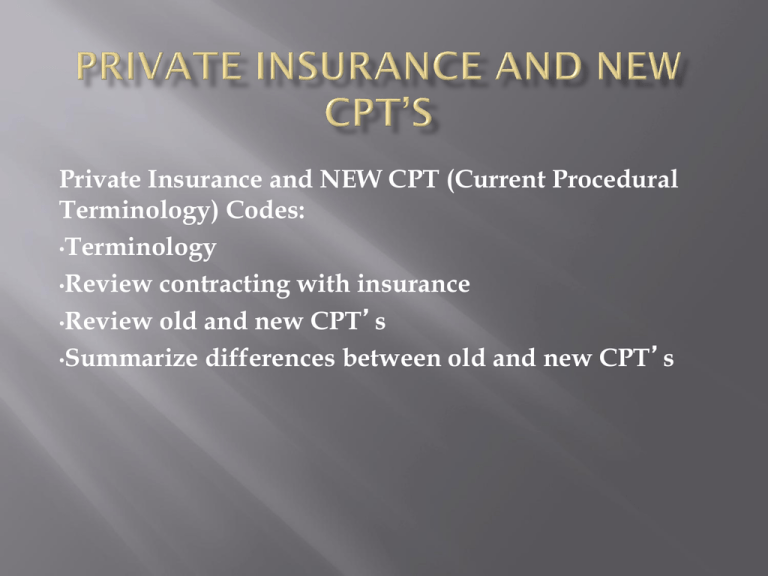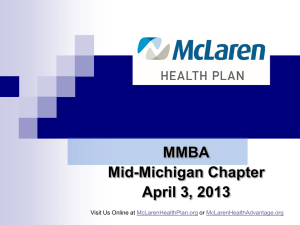Defining ABA - Kentucky Association for Behavior Analysis
advertisement

Private Insurance and NEW CPT (Current Procedural Terminology) Codes: •Terminology •Review contracting with insurance •Review old and new CPT’s •Summarize differences between old and new CPT’s •CPT = Current Procedural Terminology •In Network = provider that accepts an agreement with an insurance company •Out of Network = provider that sees patients, but does not have a contract with an insurance company •ICD 9 – International Statistical Clarification of Disease version 9 •QHCP – Qualified Healthcare Provider •Rendering Provider – the healthcare provider that actually saw the patient. •NPI – National Provider Identifier •DOI – Department of Insurance •AMA – American Medical Association •Best Fit CPT – a cpt used as a best fit when there is no AMA code. •Claim – a billing form submitted to insurance for services provided •Technician = a person who is not a BCBA or BCaBA but practices under supervision. Also called a para or therapist. •CAT III CPT – a temporary code set used to gain data on utilization of services. Used to determine if formal cpt codes are needed for a given medical service. •UNR – usual and reasonable rate. (according to an insurance company) •Max Allowable Fee – Same as UNR. The maximum the insurance company will pay for a given service. •Unit – cpt’s are based on time units. Some are 15 minutes per unit, some are 1 hour per unit, some are not time specific but product specific (like a progress note). The AMA determines the cpt’s unit, not the insurance company or provider. •Services can be provided as an “out of network” provider, but there are limitations. •If there are other in network providers in the area (within 50 miles) you will be subject to their negotiated rates despite what you charge. •In network usually allows easier claim submission and access to the companies website for claim info. •In network is subject to lower out of pocket cost for the patient. •Going in network involves the “Contracting” department of the insurance company. •You will need to fill out a complete application as an individual provider (just you), or a group provider (your company, but you will bill for other providers) •Rates are offered in what is called a “fee schedule.” Even if the insurance company says the fee schedule is not negotiable, it usually is. •The exception is if there are multiple providers in the area, then the rates are pretty much established. •How do you know if there are providers in the area? Go to the companies “Provider Directory.” •Or have the member call and ask for a Board Certified Behavior Analyst. •When there are no providers in a 50 mile radius, you can request a single case agreement. This is only for the 1 patient, but you can request to be treated as “in network” if the company doesn’t have another provider. •This helps lead to negotiations. •Deductibles: Much higher for out of network providers. •Deductible amounts are specified in the individual’s policy. •In Network vs. Out of network reimbursement. ***If there are no in network providers, the health care company must treat out of network providers as in network. Sample Comparison: $100 for a service •In network: pays at 100% plus $40 co-pay •Out of network: pays 80%, benefits do not start until a $2000 out of pocket deductible is met. •In network: client pays 40 dollars per day. No deductible. Insurance company pays $60 •Out of network: patient is responsible for the first $2000, then $20 per hour of service. Insurance pays $80 per hour. •Companies not using the NEW AMA CPT’s will continue to use “best fit” codes. •Common cpt’s to Humana and United: •H0031 – Assessment development of treatment plan. 1 hr unit •H0032 – Supervision of paraprofessional. 15 min unit •H2012 – Day Treatment, direct services 1 hr unit •H2019 – Therapeutic behavioral services 15 min unit •Humana Only: •90889 prepare patient psych report •United Only: •H0032 for graphing, report updates, revision to plan. •In July of 2014, the AMA put out new cpt’s for ABA services. •The new codes are “temporary” codes that are being used to establish the need for further development. •Insurance companies, and providers are NOT MANDATED to use these codes. •Unless you are in network, and agree to use these codes. •New cpt’s are much more specific, and require separate codes after the first unit of service. •The new codes do allow billing for services that weren’t always billable. •The new codes do not allow billing for some services that used to be billable (supervision). •The new codes do not require billing by the technician, but rather the QHCP. •When you negotiate a rate with new cpt’s, the technician is considered a practice expense. •That means, you bill the same amount if a technician sees the patient as a BCBA, in regards to treatment cpt’s. •Some cpt’s are only billable by the BCBA (0359T – behavior assessment). •0359T – Behavior Identification Assessment (flat rate 90 minutes). For initial assessment/FAI/interview/initial observation. •0360T – Observational behavior follow-up. First additional 30 minutes needed for direct observation and data collection. (ABC data, Baseline Measurements, direct assessment methods). •0361T – Each additional 30 minutes of direct observation. •Notice that what used to be billed as H0031 for most companies is now billed under 3 different CPT codes. •0362T – Exposure behavioral follow-up assessment. This is for a Functional Analysis or modified functional analysis. Used for severe challenging behaviors. Administered by BCBA and at least one or more technicians. •0363T – Each additional 30 minutes of follow up exposure assessment. •0364T – Adaptive behavior treatment by protocol. First 30 minutes of treatment. Requires protocol or behavior plan. •0365T – Each additional 30 minutes of treatment by protocol. •0366T – Group adaptive behavior treatment by protocol. First 30 minutes •0367T - Additional 30 minutes of group adaptive behavior treatment by protocol. •0368T – Adaptive behavior treatment by protocol with modification. First 30 minutes. Used to modify the protocol. Data indicate that the protocol is not resulting in the expected behavior change. •0369T – Additional 30 minutes of adaptive treatment with protocol modification. •0370T – Family adaptive behavior treatment guidance. Can be used for consulting/training family members or caregivers. Patient does not need to be present. 60 Minutes. •0371T – Multiple-Family group adaptive behavior treatment guidance. 90 Minutes. Supposed to be used when you can train a group of parents/caregivers on behavior procedures. •0372T – Social Skills Group. 90 Minutes. Up to 8 patients max. •0373T – Exposure adaptive behavior treatment with protocol modification. 60 minutes. Requiring 2 or more technicians. •0374T – Additional 30 minutes of exposure adaptive behavior treatment with protocol modification. •The new cpt’s are much more specific to the type of service you are going to render. •Most treatment cpt’s require an initial 30 minutes cpt, then 30 minutes follow-up. This could mean that you have to use the initial cpt 0364T, then 0365T for each additional 30 minutes for that day. •Some companies have said they will use the initial cpt 0364T for the first unit of service, then 0365T for each additional 30 units per authorization period (usually 6 months). •0364T, 0365T seem to overlap with 0374T, 0375T. •The main difference was the word “Exposure.” •Exposure seems to apply to more systematically contrived treatments, and is described as being more appropriate when treating more SEVERE problem behaviors (aggression or SIB). •New CPT’s will require a lot more planning when trying to do a prior authorization. •Hard to know when you will need “Adaptive Treatment Protocol Modification,” ahead of time, so a new authorization request may be needed if treatment data are not meeting goals. •New CPT’s may require billing 2 cpt’s per day of treatment, or the initial and follow-up cpt per authorization period (will vary by company). •Not all insurance companies will use the new cpt’s. Sometimes the same company may use the new cpt’s in one state but not in another state. •Do not use the new cpt’s unless you are contracted to do so. •Writing of reports and behavior plan is not a billable service. •New CPT’s include recommendations to bill all services under the QHCP or BCBA. This is good because it eliminates billing technicians, and can minimize claim denials as duplicate services when 2 therapists work with the client on the same day. •New CPT’s allow insurance company have a more clear picture of exactly what service you are will provide. •It is not yet clear how an insurance company will determine medical necessity for treatments such as family training (0307T). •It is not yet clear how an insurance company will determine medical necessity for modification of treatment protocol. •It is not yet clear how fee schedules should be adjusted to include for training of the technician and report writing. There are NO cpt’s anymore for staff training or writing up the modification to the protocol. •Consider carefully how the use of the NEW cpt’s could impact your business or practice. Factor in costs. •We will see in a few years if these CATIII temporary CPT’s become permanent cpt’s. That review will be done by the American Medical Association after they have data on CPTIII use. •Read and review the resources on ABAI’s website regarding the new cpt’s.







